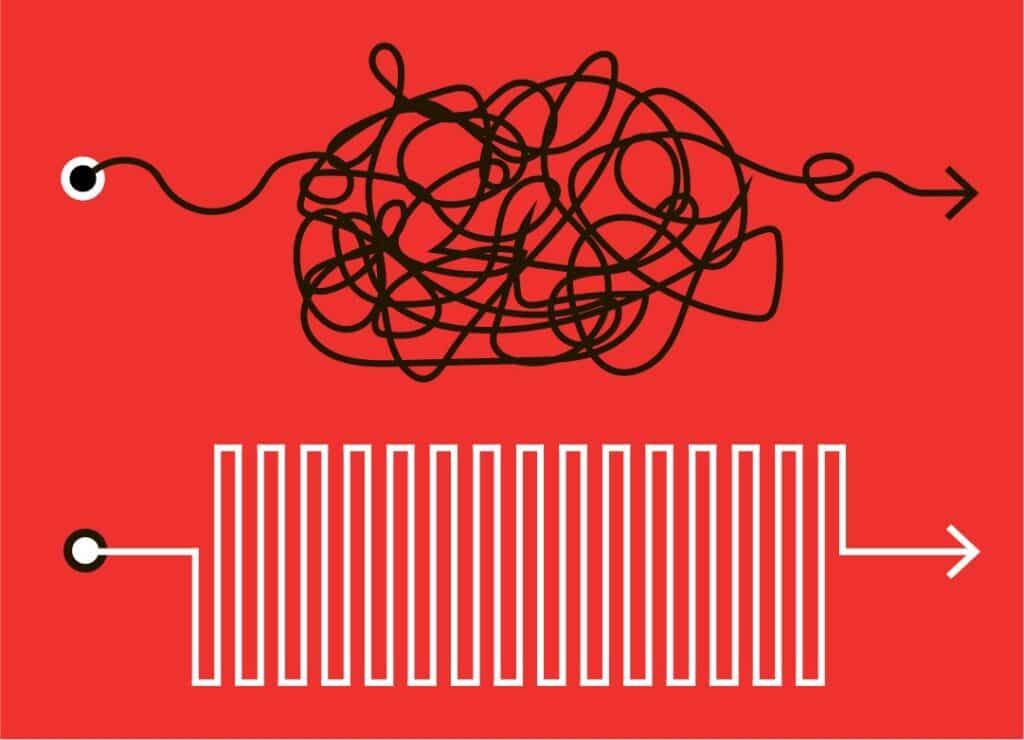Are you a symphony… or a cacophony?
Imagine settling into your middle orchestra seats, anticipating a performance of Vivaldi’s The Four Seasons. Four concertos. That solo violin, complemented by a string ensemble; every note in lock step; fifteen, twenty instruments telling a story. Forty-five minutes of pure bliss.
Unless… the violin starts in E major but the violas are in G minor. The double bass is on the wrong movement while the cellos are playing from a completely different sheet of music altogether. And the harpsichord? It never even showed up.
What should have been a beautiful symphony is instead a cacophony of noise, with nothing making sense, one instrument drowning out another, and certainly no story to be found anywhere.
This is what can happen when a company takes a siloed approach to its marketing efforts: no clear story or goal and a huge letdown in what could have been.
For marketing to be most effective, there must be a purpose, and all elements of a company’s marketing must be in support of that purpose. There is great power when a comprehensive, thoughtful strategy is behind every message and piece of content that a company is sharing with its target customer. When ads, social media, emails, PR, website, etc. messages are in alignment, the story reigns supreme, and the call-to-action is unmistakable. This results in your clear message getting to the right people and those people taking the desired action.
So what is integrated marketing?
As the old adage says, the whole is greater than the sum of its parts. And that’s equally true in marketing.
In today’s world, we deal with a lot of parts – social media, paid ads, email, web, PR, radio, OTT, billboards, print ads, and other digital and traditional marketing vehicles. And this means a whole lot of opportunity for confusion and inconsistency in place of a seamless, consistent message to your customers. The more disjointed your message is, the less likely your intended message is to get through to your prospective customer.
Integrated marketing is quite simply delivering a unified message across all channels. Taking all of the parts (channels through which you share your message) and making them whole (through a unified message). Coordinating all aspects of marketing of a company, brand, or product across channels and customer touchpoints.
Where to begin
Marketing starts and ends with your customer. Your ultimate objective in marketing is to drive behavior so it’s vital to understand who your customer is and such things as what motivates them, where they spend their time, what their pain points are, and how you can solve those (and do so better than your competition). How do you do this? Moreover, how do you do this clearly and consistently every time you interact with a prospect? You start with strategy – a framework to guide your work.
We can spend all day on strategy – in fact, at FUEL, we have an entire series on this topic.
- Strategic Secret Weapons: Part One – Consumer Insights
- Strategic Secret Weapons: Part Two – The Competition
- Strategic Secret Weapons: Part Three – Storytelling
But the point here is that you can’t integrate your marketing efforts without a plan – a strategy that is guiding every aspect of your work. Start there.
With that framework in place, you are well positioned to formulate integrated marketing campaigns to achieve a particular goal. Be it to launch a new brand or sell a new product, campaigns are tactical plans based on a common message with a focused call-to-action. In effective campaigns, consistent branding and messaging are seen across every channel used: from social media and PR to paid ads on Google or print ads in a magazine. This is the essence of integrated marketing.
You can see integrated marketing at work through most well-known brands: from Apple to M&Ms, Disney to Starbucks. Their social media presence, packaging, print ads, PR, and customer experience don’t change from one to the next. The message, the overall look and feel, and the essence of the brand are seen and felt across every channel and customer touchpoint.
Why is it important
From an agency perspective, integrated marketing efforts have countless benefits, including the following:
- Clarity and consistency in message help the customer understand what you do and, more importantly, how you can help them.
- Integration across all channels helps build brand awareness and credibility. Seeing the same message and design elements over and over again in different places helps build trust and ensures your customers remember you.
- Leveraging multiple channels allows you to expand your reach and get in front of your prospective customers wherever they are. The days of a single place to meet your customer are over. Know where they are and meet them there.
- Integrated efforts ensure your marketing is working together and all toward the same goal. This maximizes resources and budget, ensuring you are getting the greatest benefit from your investment.
An agency partner with integrated marketing experience
Marketing in today’s loud marketplace is not easy. Research has shown that people are presented with as many as 10,000 digital ads per day. That is astounding. Given such demands for your attention, it is even more vital that your messages be clear and consistent. Partnering with an expert in marketing can go a long way in helping you ensure your messages don’t get lost.
Understanding the landscape, creating a compelling message, and formulating an integrated plan for sharing that message and getting the desired results – it’s a lot more involved than it sounds.
The good news is FUEL knows how to make it happen. Integrated marketing campaigns grounded in strategy are our agency’s jam. Contact us today to talk strategy and integrated marketing.







